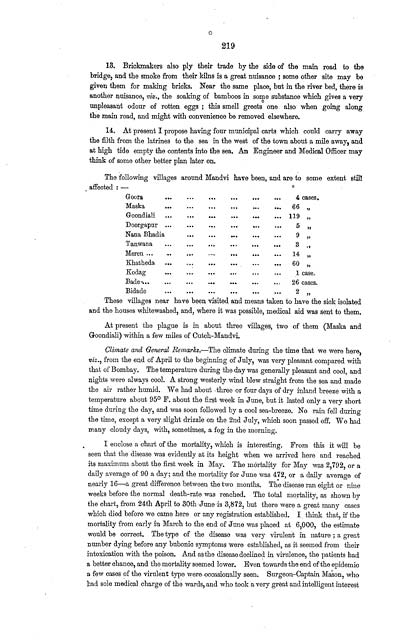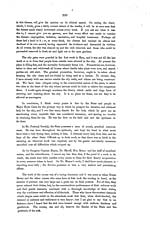Medicine - Disease > Report on the bubonic plague in Bombay, 1896-1897 > Volume 1
(233) Page 219
Download files
Individual page:
Thumbnail gallery: Grid view | List view

219
13. Brickmakers also ply their trade by the side of the main road to the
bridge, and the smoke from their kilns is a great nuisance ; some other site may be
given them for making bricks. Near the same place, but in the river bed, there is
another nuisance, viz., the soaking of bamboos in some substance which gives a very
unpleasant odour of rotten eggs ; this smell greets one, also when going along
the main road, and might with convenience be removed elsewhere.
14. At present I propose having four municipal carts which could carry away
the filth from the latrines to the sea in the west of the town about a mile away, and
at high tide empty the contents into the sea. An Engineer and Medical Officer may
think of some other better plan later on.
The following villages around Mandvi have been, and are to some extent still
affected : -
Goora
4 cases.
Maska
66
Goondiali
119 "
Doorgapur
5 "
Nana Bhadia
9 "
Tanwana
3 "
Meren
14 "
Khatheda
60 "
Kodag
1 case.
Bade
26 cases.
Bidade
2 "
These villages near have been visited and means taken to have the sick isolated
and the houses whitewashed, and, where it was possible, medical aid was sent to them.
At present the plague is in about three villages, two of them (Maska and
Goondiali) within a few miles of Cutch-Mandvi.
Climate and General Remarks.-The climate during the time that we were here,
viz., from the end of April to the beginning of July, was very pleasant compared with
that of Bombay. The temperature during the day was generally pleasant and cool, and
nights were always cool. A strong westerly wind blew straight from the sea and made
the air rather humid. We had about three or four days of dry inland breeze with a
temperature about 95 F. about the first week in June, but it lasted only a very short
time during the day, and was soon followed by a cool sea-breeze. No rain fell during
the time, except a very slight drizzle on the 2nd July, which soon passed off. We had
many cloudy days, with, sometimes, a fog in the morning.
I enclose a chart of the mortality, which is interesting. From this it will be
seen that the disease was evidently at its height when we arrived here and reached
its maximum about the first week in May. The mortality for May was 2,792, or a
daily average of 90 a day; and the mortality for June was 472, or a daily average of
nearly 16-a great difference between the two months. The disease ran eight or nine
weeks before the normal death-rate was reached. The total mortality, as shown by
the chart, from 24th April to 30th-June-is 8,872, but there were a great many cases
which died before we came here or any registration established. I think that, if the
mortality from early in March to the end of June was placed at 6,000, the estimate
would be correct. The type of the disease was very virulent in nature ; a great
number dying before any bubonic symptoms were established, as it seemed from their
intoxication with the poison. And as the disease declined in virulence, the patients had
a better chance, and the mortality seemed lower. Even towards the end of the epidemic
a few cases of the virulent type were occasionally seen. Surgeon-Captain Mason, who
had sole medical charge of the wards, and who took a very great and intelligent interest
13. Brickmakers also ply their trade by the side of the main road to the
bridge, and the smoke from their kilns is a great nuisance ; some other site may be
given them for making bricks. Near the same place, but in the river bed, there is
another nuisance, viz., the soaking of bamboos in some substance which gives a very
unpleasant odour of rotten eggs ; this smell greets one, also when going along
the main road, and might with convenience be removed elsewhere.
14. At present I propose having four municipal carts which could carry away
the filth from the latrines to the sea in the west of the town about a mile away, and
at high tide empty the contents into the sea. An Engineer and Medical Officer may
think of some other better plan later on.
The following villages around Mandvi have been, and are to some extent still
affected : -
Goora
4 cases.
Maska
66
Goondiali
119 "
Doorgapur
5 "
Nana Bhadia
9 "
Tanwana
3 "
Meren
14 "
Khatheda
60 "
Kodag
1 case.
Bade
26 cases.
Bidade
2 "
These villages near have been visited and means taken to have the sick isolated
and the houses whitewashed, and, where it was possible, medical aid was sent to them.
At present the plague is in about three villages, two of them (Maska and
Goondiali) within a few miles of Cutch-Mandvi.
Climate and General Remarks.-The climate during the time that we were here,
viz., from the end of April to the beginning of July, was very pleasant compared with
that of Bombay. The temperature during the day was generally pleasant and cool, and
nights were always cool. A strong westerly wind blew straight from the sea and made
the air rather humid. We had about three or four days of dry inland breeze with a
temperature about 95 F. about the first week in June, but it lasted only a very short
time during the day, and was soon followed by a cool sea-breeze. No rain fell during
the time, except a very slight drizzle on the 2nd July, which soon passed off. We had
many cloudy days, with, sometimes, a fog in the morning.
I enclose a chart of the mortality, which is interesting. From this it will be
seen that the disease was evidently at its height when we arrived here and reached
its maximum about the first week in May. The mortality for May was 2,792, or a
daily average of 90 a day; and the mortality for June was 472, or a daily average of
nearly 16-a great difference between the two months. The disease ran eight or nine
weeks before the normal death-rate was reached. The total mortality, as shown by
the chart, from 24th April to 30th-June-is 8,872, but there were a great many cases
which died before we came here or any registration established. I think that, if the
mortality from early in March to the end of June was placed at 6,000, the estimate
would be correct. The type of the disease was very virulent in nature ; a great
number dying before any bubonic symptoms were established, as it seemed from their
intoxication with the poison. And as the disease declined in virulence, the patients had
a better chance, and the mortality seemed lower. Even towards the end of the epidemic
a few cases of the virulent type were occasionally seen. Surgeon-Captain Mason, who
had sole medical charge of the wards, and who took a very great and intelligent interest
Set display mode to: Large image | Zoom image | Transcription
Images and transcriptions on this page, including medium image downloads, may be used under the Creative Commons Attribution 4.0 International Licence unless otherwise stated. ![]()
| India Papers > Medicine - Disease > Report on the bubonic plague in Bombay, 1896-1897 > Volume 1 > (233) Page 219 |
|---|
| Permanent URL | https://digital.nls.uk/74580134 |
|---|




